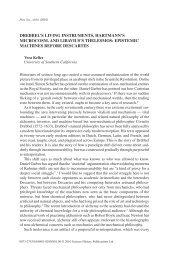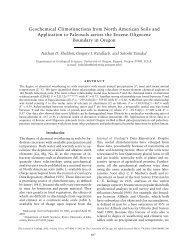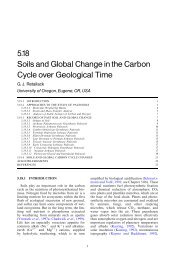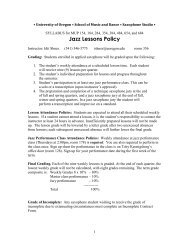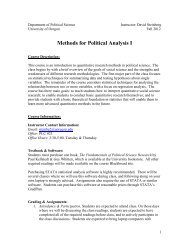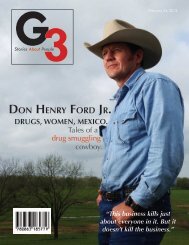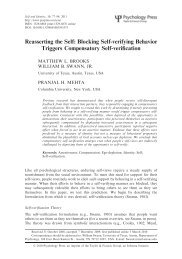Retallack 2007 Proserpina principle - University of Oregon
Retallack 2007 Proserpina principle - University of Oregon
Retallack 2007 Proserpina principle - University of Oregon
Create successful ePaper yourself
Turn your PDF publications into a flip-book with our unique Google optimized e-Paper software.
Foreman, 1992), indicating modest carbonstorage in soil organic matter and carbonatecompared, e.g., with modern savanna grasslandsoils (de Wit, 1978). The Ordovician paleosolsstudied so far show unusually high soil respiration,considering their probable low levels <strong>of</strong>primary productivity. They also formed at atime estimated from sedimentary mass balancemodels as the steamiest greenhouse period <strong>of</strong>all Phanerozoic time, with B16 times thepresent atmospheric levels <strong>of</strong> CO 2 (Berner andKothavala, 2001). The carbon budget <strong>of</strong>known Ordovician paleosols would have contributedto this greenhouse.5.18.3.5 Terminal Ordovician IcehousePaleosolsPeriglacial paleosols, unknown in Cambrianand Early to Middle Ordovician rocks, arefound again in latest Ordovician (Hirnantian)rocks. Periglacial paleosols are best documentedin South Africa, where patterned ground andsand wedges are common in red beds <strong>of</strong> thePakhuis Formation (Daily and Cooper, 1976).The ice sheets extended over much <strong>of</strong> Africa(Ghienne, 2003).The causes <strong>of</strong> this ice age areespecially enigmatic, because volcanic activityincreased through the Ordovician and the continentswere dispersed (Bluth and Kump, 1991),thus working against cold Late Ordovicianpoles. Mass balance models make the Ordovicianice age seem particularly enigmatic, becausethey predict atmospheric CO 2 levels 16times PAL (Berner and Kothavala, 2001). Thismay be an artifact <strong>of</strong> the 10 Ma spacing <strong>of</strong> datapoints in the model, blurring the o10 Ma duration<strong>of</strong> the ice age that is indicated by carbonisotopic data (Brenchley et al., 1994). Studies <strong>of</strong>carbonate isotopic compositions from paleosolswithin the glacial interval are needed to reexaminethis question. Also needed is an examination<strong>of</strong> paleosols within this interval forevidence <strong>of</strong> fossil mosses, which would havebeen more deeply rooted than liverworts andso have accelerated weathering and carbonsequestration. Rare Late Ordovician mosslikemegafossils (Snigirevskaya et al., 1992) andspores (Nøhr-Hansen and Koppelhus, 1988)support indications from cladistic analysis(Kenrick and Crane, 1997) for a latest Ordovicianorigin <strong>of</strong> mosses.5.18.3.6 Siluro-Devonian GreenhousePaleosolsRoot traces <strong>of</strong> vascular land plants appear inSilurian paleosols, but until the Early Devonian,Record <strong>of</strong> Past Soil and Global Change 13root traces are small and shallow within thepr<strong>of</strong>iles (Figure 9b). The earliest known vascularland plants <strong>of</strong> the Middle and Late Silurianlacked true roots. Instead, they had stems thatran along the surface and just beneath the surface<strong>of</strong> the soil as runners and rhizomes furnishedwith thin unicellular root hairs (Kenrickand Crane, 1997). Plant bioturbation in soilsonly extended down to a few centimeters, butburrows <strong>of</strong> millipedes reached more deeply, andin some soils were more abundant than planttraces (<strong>Retallack</strong>, 1985). In addition to detritivorousand perhaps also herbivorous millipedes(<strong>Retallack</strong>, 2001c), Late Silurian soil faunasincluded predatory centipedes and spiderliketrigonotarbids (Jeram et al., 1990). Fungalhyphae and spores in Silurian and Devonianrocks indicate proliferation <strong>of</strong> chytrids and otherfungi (Sherwood-Pike and Gray, 1985; Taylorand Taylor, 2000).Early Devonian paleosols have abundanttraces <strong>of</strong> true roots, including woody tap roots<strong>of</strong> a variety <strong>of</strong> land plants (Elick et al., 1998).Root traces reached tens <strong>of</strong> centimeters downinto paleosols, extending greatly the depth <strong>of</strong>the active rhizosphere and its associatedmucigel <strong>of</strong> microbes. Among the numerousroots <strong>of</strong> Early and Middle Devonian paleosols,the burrows <strong>of</strong> soil fauna are less prominent(Figure 9b). Devonian soils also have higherclay content and are more deeply weathered <strong>of</strong>bases than Silurian or Ordovician soils (Figure9a). They have isotopically lighter pedogeniccarbon, closer to the isotopic composition <strong>of</strong>coexisting organic carbon, than Silurian andOrdovician paleosols (Mora et al., 1996; Moraand Driese, 1999). Within the parameters <strong>of</strong> thepedogenic carbonate palaeobarometer <strong>of</strong> Cerling(1991), these data indicate declining atmosphericlevels <strong>of</strong> CO 2 from the Silurian intothe Devonian (Figure 9c). Consumption <strong>of</strong> atmosphericCO 2 by increased hydrolytic weathering,and burial <strong>of</strong> carbon in limestone andorganic matter during the Silurian and Devonianhas been widely interpreted as an instance<strong>of</strong> atmospheric global change induced by theevolution <strong>of</strong> life (<strong>Retallack</strong>, 1997b; Berner,1997; Algeo and Scheckler, 1998).5.18.3.7 Late Devonian to Permian IcehousePaleosolsPeriglacial paleosols and glaciogene sedimentaryfacies unknown in Silurian and Earlyto Middle Devonian appear in the latestDevonian, and remain locally common inCarboniferous and Permian rocks, especiallywithin the Gondwana supercontinent, then positionednear the south pole (Figure 10; Krull,



